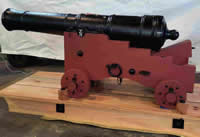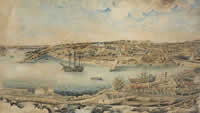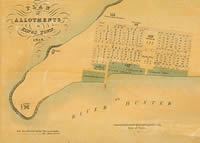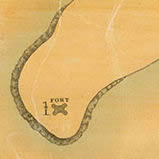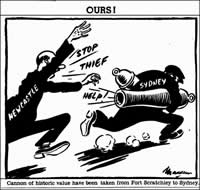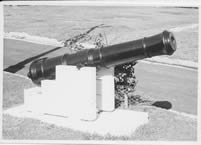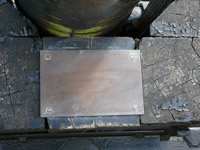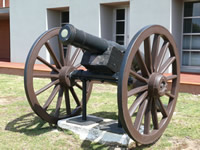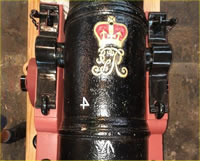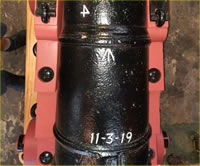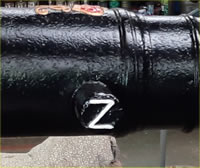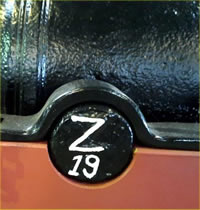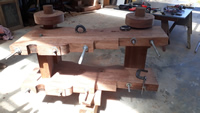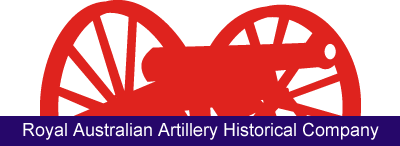
|
|||||||||||||||||||||||||||||||||||||||||||||||||||||||||||||||||||||
Gun History:
This 4-pounder 11 cwt smooth bore muzzle loading gun is one of the most significant guns in the military history and history of Australia. It is believed to be one of the ten 4-pounder guns from HMS Supply (2) and therefore represents the second batch of guns used in the defence of the settlement, the first being guns from HMS Sirius. The barrel contains the cypher of King George III meaning the barrel was cast between 1760 and 1820. The weight of the barrel is marked 11-3-19 (hundredweight-quarters-pounds) (1335 kg). It is also stamped with the broad arrow indicating it was accepted for military service. No date is stamped on the barrel but a manufacturer’s mark of “Z” appears on both trunnions. No record could be found of this manufacturers stamp so contact was made with the Royal Armouries in the UK and Mr Philip Mcgrath, Curator of Artillery, advised that notes they hold show this is the mark of George Matthews of Calcutts near Broseley in Shropshire – very near Ironbridge. In 1778, he and his business partner Francis Homfray commenced casting guns for the Board of Ordnance until around 1785 when he became bankrupt. It seems that he was also a sub-contractor for Henkell of Wandsworth, London.
Initially a rough measurement of the calibre of the gun 3.5 inches (88.9 mm) indicated this gun may have been a 6-pounder. A comparison of this gun with the Sirius gun on display at Macquarie Place, Sydney, saw similarities as that gun also bears the manufacturers mark ‘Z’. But the 11 cwt weight of the barrel placed doubt in our mind as the lightest common 6 pounder gun weighed 16 cwt. 11 cwt indicated the gun would more likely be a 4 pounder. The calibre of a 4 pounder being 3.2 inches (81.3 mm) and that of a 6 pounder being 3.67 inches (93.2 mm).
This HMS Supply should not be confused with the HMS Supply of the First Fleet, it was its replacement. On 11 March 1791 Robinson Reid, the carpenter of the Supply completed a report on the condition of the ship. It concluded ‘It is my opinion his Majesty’s armed tender Supply, will want, in the course of another year, a total repair, and which cannot be done in this country conveniently.’ Reid and John Boyd, carpenter of HMS Gorgon inspected Supply again and reported on 24 September 1791 ‘the Supply is in the greatest want of a thorough repair’. On 26 November 1791 Supply weigh’d anchor from Sydney Cove and returned to the United Kingdom reaching Plymouth on 21 April 1792. The Admiralty sold her at auction in July 1792.
A replacement ship was required and in October 1793 the Admiralty purchased the American mercantile ship New Brunswick which was commissioned in April 1794 as HMS Supply. A 29.7 metre vessel fitted to carry stores and livestock she was armed with ten 4-pounder guns. In company with HMS Reliance she sailed for New South Wales on 15 February 1795 arriving in Sydney on 7 September 1795. Notable crew and members on the Reliance were Matthew Flinders, George Bass, the new Governor John Hunter and the aboriginal Bennelong.
In September 1796 Governor Hunter ordered Supply and Reliance to the Cape of Good Hope to obtain stores and livestock for the colony. They returned to Sydney on 16 May 1797. In addition to the supplies for the colony both ships brought back Merino sheep. It is said the ships commanders, being friends of John Macarthur, were requested by him to procure any good sheep which they could buy. Others say it was the ships commanders, Lieutenant William Kent and Captain Henry Waterhouse, initiative to purchase 26 sheep when it was found they were for sale, previously the sale of Merino was tightly controlled by the Spanish monarchy, and sold some of them to Macarthur. It was a significant moment in the history of Australia.
In July 1797 Governor Hunter informed Secretary Nepean ‘that the Supply returned to this port on 16th of May in a most distressing and dangerous condition. When the Supply returned to Sydney it was found to be in unseaworthy condition. … I have made known this unfortunate circumstances to the Duke of Portland, and informed his Grace how necessary it will be to have a ship sent out instead of the Supply, which ship I can only now use as a guard ship in the port.’ By August 1798 the Supply had been cut down to the lower deck and was being used as a hulk for stores and in the ships Log on 13 August mention is made of moving the guns to the battery at Bennelong which had been constructed using members of the ship’s crew.
The Historical Record of Australia, Hunter to J. King pp 560-561 entry dated 25 Sept 1800 reports under the heading ‘Return of public buildings erected in New South Wales since October 1796’ - Built embrazures to the battery on Point Maskelyne (the west point [this is Dawes Battery]), and raised a redoubt with eight embrazures on the east point [Bennelong point], on which were mounted a part of the guns of HM ship Supply. Two guns were likewise mounted on the high part of Garden Island. Interestingly the records for guns in 1800 indicate 6-pounder guns at East Point and Garden Island which might indicate an error in the record.
The Supply was broken up in 1806 and earlier entries in the Log indicate the guns remained in the colony. But records for the colony seldom mention 4 pounders in any fortifications. Excess/older guns may have been used for settlements outside the Sydney area which are not recorded in the records such as Port Macquarie, Fort Essington in the Northern Territory, etc
It is possible a couple of 4-pounders were sent to Newcastle and placed in a fort in 1828. Returns for 1861, 1864 and 1869 show two 4 pounders guns at Newcastle, both unserviceable. One of these guns ended up in Fort Scratchley, possibly as a decoration. No 4-pounders are recorded at Newcastle in the 1901 report which indicates they were not in operation. By this time the obsolete guns were used as ornaments and over the years fell into disrepair. A report in the Newcastle Morning Herald and Miners Advocate of 17 October 1951 contains an article with the headline ‘Historic Cannon Removed from Fort Scratchley’. It mentions three cannons being lifted out of the fort moat where they had been lying over grown by grass for many years. One barrel is identified as being cast in 1819, the date being incorrectly based on 11/3/19 marked on the barrel. In fact this is the weight of the barrel but the error allows us to identify it as the gun at Puckapunyal. The article also indicates the guns had been removed by the Army, who occupied the Fort at that time, and were being removed to the barracks of 1 Field Regiment at Middle Head where they were to be used to ornament the parade ground and officers’ mess area.
There was objection raised about the removal and the Mayor of Newcastle, Alderman Purdue demanded their return. This obviously fell on deaf ears. Eventually the gun was moved to the School of Artillery at North Head where it was mounted on a crude naval style carriage near the flag pole at North Fort. In 1985, during the School’s centenary celebration, the School’s Regimental Sergeant Major, WO1 Barry Cane and Master Gunner WO1 Kevin Browning, obtained a set of wheels from a farmer near Bathurst and with the assistance of the workshop constructed a field carriage to better display the barrel which at that time was believed to have been of 1870 vintage. When the School moved to Puckapunyal in 1997 the gun was moved and set-up in front of the Combined Officers and Sergeants Mess. In 2016 during a prank by students from one of the courses the carriage sustained damage. In an effort to restore the carriage WO2 Darrin Neale contacted the Royal Australian Artillery Historical Company seeking information on the carriage and so began the correct identification of the barrel and plans for a new carriage.
In 2019 the RAAHC agreed to fund the carriage and barrel restoration and work commenced by volunteers at North Head, Sydney (Sydney Harbour Federation Trust Volunteers). COVID restrictions stopped the work and it was not until March 2021 that the work was completed and the gun, carriage and display platform moved back to the School of Artillery.

- 4 Pounder 11 cwt Smooth Bore Muzzle Loading Gun
The 4 Pounder 11 cwt Smooth Bore Muzzle Loading Gun at North Head 2021 prior to movement to Puckapunyal
- 4 Pounder 11 cwt Smooth Bore Muzzle Loading Gun
Sydney circa 1800. Bennelong Point is the land strip jutting at left into the cove. The ship beached at right is possibly the HMS Supply.
- 4 Pounder 11 cwt Smooth Bore Muzzle Loading Gun
Plan of Allotments at Kings Town 1828. Kings Town was the original name given to Newcastle, NSW. On the plan the site of the fort at the head land can be seen.
- 4 Pounder 11 cwt Smooth Bore Muzzle Loading Gun
Enlargement from the Plan.
- 4 Pounder 11 cwt Smooth Bore Muzzle Loading Gun
In March 1951 this cartoon appeared in the local Newcastle paper along with a demand the guns be returned.
- 4 Pounder 11 cwt Smooth Bore Muzzle Loading Gun
The barrel on a crude naval carriage at North Fort, North Head, Manly circa 1974.
- 4 Pounder 11 cwt Smooth Bore Muzzle Loading Gun
Brass plate placed on the replica carriage by RSM WO1 Cane in 1985. Now badly worn the inscription is difficult to read, some being illegible. What can be read appears to be:
SERGEANTS MESS CENTENARY GUN
BRITISH 6 PDR SB GUN 1862
PRESENTED BY WO1 CANE/BROWNING
WARRANT OFFICERS AND SERGEANTS
- 4 Pounder 11 cwt Smooth Bore Muzzle Loading Gun
The gun and replica carriage at Puckapunyal 2009.
- 4 Pounder 11 cwt Smooth Bore Muzzle Loading Gun
Cypher of King George III and broad arrow. The number 4 inscribed into the barrel is believed to indicate the guns position on the ship or within the fort.
- 4 Pounder 11 cwt Smooth Bore Muzzle Loading Gun
The weight of the barrel 11 - 3 – 19 (hundredweight, quarters and pounds).
- 4 Pounder 11 cwt Smooth Bore Muzzle Loading Gun
The manufacturers mark cast on the right trunnion.
- 4 Pounder 11 cwt Smooth Bore Muzzle Loading Gun
The manufacturers mark cast on the left trunnion is smaller than that on the right trunnion and below this mark is inscribed the serial number 19.
- 4 Pounder 11 cwt Smooth Bore Muzzle Loading Gun
The carriage under construction at North Head.
